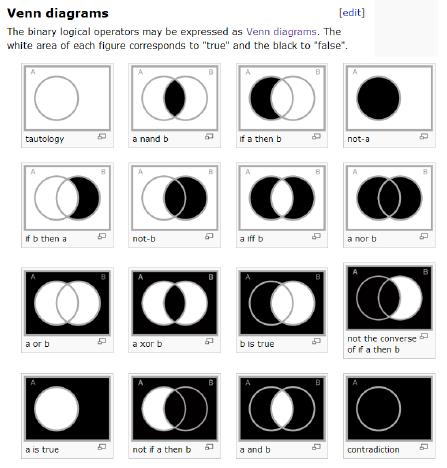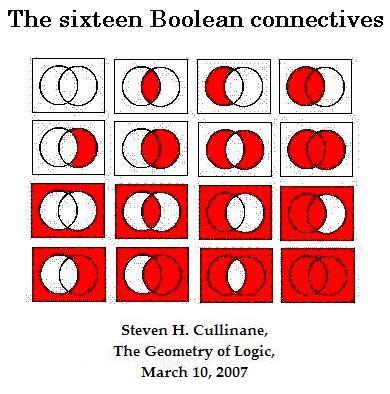Venn Diagrams
and Finite Geometry
and Finite Geometry
On June 25, 2007, Wikipedia user Gregbard added the following to the "Logical Connective" article in Wikipedia:

Greg Bard, June 25, 2007
Earlier in 2007, on March 10, Steven H. Cullinane published a web page, "The Geometry of Logic," with the identical arrangement:

As that web page makes clear, the arrangement of the 16 parts is an essential part-- indeed, the essential part, of the above figure. Bard calls the Venn subdiagrams "Johnston diagrams." The Wikipedia article on such diagrams links to a website with the following illustration:

Russell Johnston,
undated illustration
From the parent page of the
above illustration:
"Logic images and diagramming concepts
© copyright Russell Johnston
and LogicTutorial.com 1987"
undated illustration
From the parent page of the
above illustration:
"Logic images and diagramming concepts
© copyright Russell Johnston
and LogicTutorial.com 1987"
The haphazard arrangement of the parts in this figure
may serve as a contrast to the Cullinane arrangement, which has certain
remarkable
geometric properties.
Bard has stated that he arrived at his arrangement independently. As the page "The Geometry of Logic" indicates, the arrangement follows in a straightforward way from Knuth's table of the 16 Boolean connectives by simply replacing Knuth's vertical ordering of the connectives by a 4x4 left-to-right, top-to-bottom ordering. Bard's declaration of independence is therefore not without credibility.
The seemingly obvious 4x4 arrangement has, as indicated in "Geometry of the 4x4 Square," certain remarkable properties of interest in both group theory and finite geometry. Its provenance is therefore of interest.
Bard has stated that he arrived at his arrangement independently. As the page "The Geometry of Logic" indicates, the arrangement follows in a straightforward way from Knuth's table of the 16 Boolean connectives by simply replacing Knuth's vertical ordering of the connectives by a 4x4 left-to-right, top-to-bottom ordering. Bard's declaration of independence is therefore not without credibility.
The seemingly obvious 4x4 arrangement has, as indicated in "Geometry of the 4x4 Square," certain remarkable properties of interest in both group theory and finite geometry. Its provenance is therefore of interest.
-- Steven H. Cullinane, September 28, 2007, 7:40 PM ET